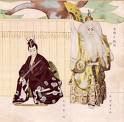:::::::::::::::::::::::::::::::::::::::::::::::::::::::::::::::::::::::::::::::::::::::::::::::::::
Azuma Dance (Azuma odori)
***** Location: Tokyo
***** Season: Late spring
***** Category: Observance
*****************************
Explanation
Azuma Dance, (Tokyo Dance) Azuma odori
東踊 (あずまおどり) / 東をどり
some saijiki quote it as a kigo for summer

Azuma is an old name for the area in the Kanto plain, including Tokyo.
The geisha of the Shinbashi area performed this spring dance.
It dates back to 1857, when a new road had been constructed to connect this area with the Ginza and many geisha houses started to be built there. It soon became a place of international mingling and dancing.
:::::::::::::::::::::::::::::::::::::::::::::::::::::::::::::::::::::::::::::::::::::::::::::::::::
Adzuma Tokuya tells us
Thank you for visiting our official "Japanese Traditional Dance" (Adzuma-Ryu 吾妻流) home page.
About 200 years ago, Edo-Sanza (Nakamura-Za, Ichimura-Za, Morita-Za), the official Kabuki theater in the Edo era flourished. Adzuma Tozo, a choreographer of Ichimura-Za started Adzuma-Ryu as a direct descendent. The name of Adzuma Tozo 吾妻東蔵 was inherited from the first to the third, and thereafter Adzuma-Ryu ceased for a period of time.
In the beginning of the Showa era, my grandmother, Fujima Harue 藤間春枝, the daughter of the dominant kabuki actor, Ichimura Hazaemon 15th, succeeded to the 4th head and revived Adzuma-Ryu. The 4th head Fujima Harue then changed her name to Adzuma Harue and then again changed it to Adzuma Tokuho 徳穂. She used her influence to elevate the status of Adzuma-Ryu before the World War II.
....
Through Adzuma-Ryu we, ourselves enjoy observing traditional things and focus our efforts on harmonizing things traditonal with things modern.
We hope you will become familiar with Japanese Traditional Dance through this site.
© www.adzuma.com

:::::::::::::::::::::::::::::::::::::::::::::::::::::::::::::::::::::::::::::::::::::::::::::::::::
The following is a direct except from the Azuma Odori programme from Autumn 1951, from the private collection of Naomi Graham-Diaz, ImmortalGeisha.com.
1.“Imayo Kokaji”Sanjo Kokaji (Swordsmith)
This dance was first put on the stage in 1852. the idea of this dance was taken from one of the old no plays connecting with the Japanese Story in which Sanjo Munechika, a swordsmith, with the help of the divine Inari Fox spirit, forged a fine sword called Ogitsune-Maru (Little-fox).
2. “Korin Byobu”
(Paper screen with a picture painted by Korin)
and many more

© www.immortalgeisha.com

Blacksmith and Divine Fox
Ogata Gekko (1859-1920)
. kajiya 鍛冶屋 kajishi 鍛冶師 blacksmith .
*****************************
Worldwide use
*****************************
Things found on the way
*****************************
HAIKU
教師に一夜東をどりの椅子紅し
kyooshi ni ichiya Azuma odori no isu benishi
Nomura Toshiro 能村登四郎
:::::::::::::::::::::::::::::::::::::::::::::::::::::::::::::::::::::::::::::::::::::::::::::::::::
this Azuma Dancer ...
she throws a quick kiss
at her patron
Gabi Greve, May 2008
*****************************
Related words
***** Miyako Odori .. "Dance of the Capital" in Kyoto
***** Kamogawa Odori .. Kamogawa Dance in Kyoto
***** Naniwa Odori ... Naniwa Dance in Osaka
***** Shimabara Odori .. Shimabara Dance, Kyoto
***** Azuma Odori .. Azuma Dance, Tokyo Dance
. azumagiku 東菊 "Azuma chrysanthemum" .
..... azumagiku 吾妻菊(あずまぎく)
Gymnaster savatieri
- #azumadance -
:::::::::::::::::::::::::::::::::::::::::::::::::::::::::::::::::::::::::::::::::::::::::::::::::::::::::::::::::::::::::::
[ . BACK to DARUMA MUSEUM TOP . ]
[ . BACK to WORLDKIGO . TOP . ]
:::::::::::::::::::::::::::::::::::::::::::::::::::::::::::::::::::::::::::::::::::::::::::::::::::::::::::::::::::::::::::






2 comments:
Indulge yourself in the art of geisha at the 84th annual Azuma Odori dance gala in Tokyo's Shinbashi district from May 29 to June 1, 2008 !
Shinbashi has prospered since the Edo Period (1603-1868) as a center of restaurants where geisha — traditional female entertainers — have provided singing, dancing, conversation, games and companionship to customers.
Friday, May 23, 2008 / Japan Times
Shinbashi fetes its geisha culture
By ERIKO ARITA
Indulge yourself in the art of geisha at the 84th annual Azuma Odori dance gala in Tokyo's Shinbashi district from May 29 to June 1.
Shinbashi has prospered since the Edo Period (1603-1868) as a center of restaurants where geisha — traditional female entertainers — have provided singing, dancing, conversation, games and companionship to customers.
Three shows each day will feature about 60 geisha on three different stages performing traditional Japanese dances, songs and music that has developed in Tokyo over the past 150 years.
The show includes a group of geisha who performed at the U.S. National Cherry Blossom Festival in Washington, D.C., in April.
The opening number is titled "Ume no Sakae (prosperity of plum blossoms)," accompanied by "Nagauta," a lyrical song that is performed in Kabuki. It was choreographed by Sakon Nishikawa, the headmaster of the Nishikawa School of Dance.
In it, geisha also play shamisen (three-stringed banjo), taiko (drums), and tsuzumi (hand drum) as accompaniment.
The second act is titled "Omatsuri (Festival)," a colorful dance choreographed by Kikunojo Onoe, the headmaster of the Onoe School of Dance.
The third act, consisting of eight scenes, depicts a pageant of competing flowers traditionally linked to famous sites in Edo, the capital's old name.
"Hanakisoi Oedo Hakkei" was choreographed by Jusuke Hanayagi, the headmaster of the Hanayagi School of Dance. The pageant covers the plum blossoms in Nihonbashi, the cherry blossoms in Yoshiwara, the wisteria in Kameido, the iris paddies in Horikiri, autumn flowers in Mukojima, chrysanthemums of Asakusa, and the peony fields of Ueno.
The Azuma Odori (May 29 to June 1) is being staged at the Shinbashi Enbujyo theater, a five-minute walk from Higashi Ginza Station on the Hibiya and Asakusa subway lines, and a three-minute walk from Tsukiji Ichiba Station on the Oedo subway line.
Post a Comment